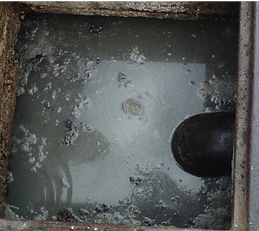
Trampas de Grasa - ¿Solución Definitiva?

Las trampas de grasa son la primera línea de defensa para evitar que grasas y aceites lleguen a las tuberías de drenaje y causen estragos en las mismas y en otras instalaciones aguas abajo.
La mayoría de las ciudades exigen la instalación de trampas de grasa como paso previo a la habilitación de un Restaurante u Hotel.
En algunos lugares se exige el cumplimiento de un plan de limpieza con la remoción y traslado de las grasas, por parte de una empresa autorizada, a un sitio de disposición final.
¿Como funcionan?
%201.png)
Las trampas de grasa funcionan por gravedad, en el flujo de agua que se descarga desde las tarjas hay elementos más pesados que se decantan hacia el fondo (sólidos húmedos pesados) y las grasas (junto con los sólidos húmedos livianos) que flotan hacia la superficie. Los sólidos húmedos son por lo general restos de comida que pasan a través de las coladeras. La salida de la trampa debe de tener un codo (con una entrada de aire fuera de la trampa) ó una "T" interna, para evitar que la grasa de la superficie escape hacia el drenaje.
%201.png)

El nivel de agua dentro de la trampa está definido por la parte inferior del tubo de salida, el espacio disponible entre el nivel de agua y el techo de la trampa, multiplicado por el área, es aproximadamente la capacidad de la trampa. El espacio entre entre la base y el techo, multiplicado por el área, da el volumen total de la trampa.
Tiempo de retención: es el tiempo necesario para que la gravedad actúe y produzca una separación efectiva de la grasa, este valor puede ser de 3 a 5 minutos. Tomando ese valor de referencia y el flujo máximo de la descarga, se puede definir el volumen que debe de tener la trampa.
Tubería de salida: debe de estar separada del fondo una distancia suficiente para que el flujo de agua saliente no succione los sólidos estacionados en el fondo.
Limpieza: la grasa de las trampas debe ser retirada frecuentemente para para evitar que llegue al techo o que por su propio peso salga por el tubo de drenaje. Dependiendo de la actividad y de el tipo de comida, una cocina activa puede necesitar que su trampa se limpie hasta 3 -4 veces por semana.
Infelizmente, por más que las trampas se limpien muy seguido, la grasa siempre encuentra la manera de llegar al drenaje.
La secuencia de fotos siguiente, muestra la trampa de una instalación con un riguroso sistema de limpieza, la cocina funciona las 24 horas, con turnos rotativos de personal cada 8 horas, cada cambio de turnos las trampas se limpian, es decir 3 veces por día.
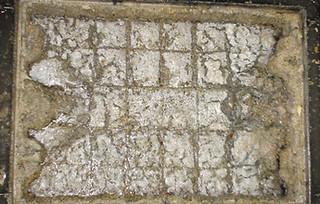
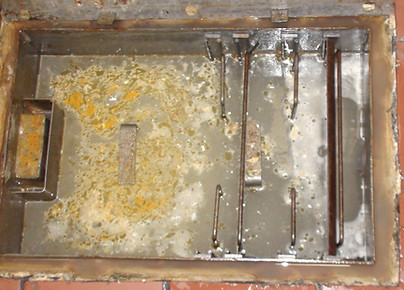


La primera foto, muestra una de las trampas de grasas perfectamente mantenida, la segunda es una foto de un cárcamo de recolección externo donde hay alrededor de un pie de grasa acumulada (se vacían cada 10-15 días), finalmente la tercera muestra la superficie de la fase aeróbica de la Planta de Tratamiento, donde se percibe grasa en la superficie.
Sobre trampas de Grasa, Sólidos Húmedos, Detergentes y Bacterias
Si bien las trampas de Grasa son un dispositivo necesario, y en algunos casos de instalación obligatoria, en cocinas de gran actividad, no es verdad que contengan hasta el 97% de la grasa que les entra. Por diversos factores: Temperatura del agua, uso de detergentes, limpieza inadecuada, no se respeta el tiempo de retención de la trampa, etc, etc,etc,. Las Grasas escapan de la trampas. Veamos algunos de ellos:
Temperatura del agua
La temperatura del agua, afecta la consistencia y la fluidez de las grasas, haciéndolas más solubles en agua a medida de que la temperatura aumenta. Por su puesto, cuando la temperatura baja la grasa vuelve a solidificarse y adherirse a la paredes de las tuberías de descarga.De hecho en algunas ciudades los municipios recomiendan colocar enfriadores en la salida de las trampas justamente para frenar la grasa dentro de las instalaciones privadas y evitar que la misma llegue a los drenajes públicos.
Uso de detergentes
Los detergentes son surfactantes, es decir bajan la tensión superficial entre fases lo que permite que la grasa y el agua de alguna manera se mezclen en una emulsión, son excelentes para limpiar superficies (los platos quedan perfectos) pero, la moléculas que generan son muy grandes y poco estables, lo que hace que se rompan aguas abajo y liberen las grasas nuevamente. Esto es muy fácil de demostrar en la práctica: TODOS LAS COCINAS DEL MUNDO USAN DETERGENTES PARA LIMPIAR SU VAJILLA Y TODAS TIENEN PROBLEMAS DE GRASA.
No importa si es un detergente industrial, biodegradable, verde, con cloro o lo que fuera: NO EXISTE TAL COSA COMO EL "DETERGENTE COME GRASAS"
Falta de Limpieza o Mantenimiento inadecuado
Es muy importante que el personal de mantenimiento o el proveedor del servicio de limpieza de trampas este familiarizado con el funcionamiento de las mismas,

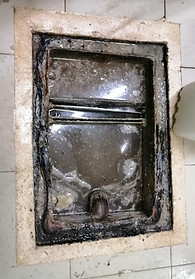
En la trampa de la foto de la izquierda no se ve grasa flotando en la entrada, pero sí sobre el codo de salida, debería verse más grasa a la entrada, el hecho de que esté limpia nos indica que cuando hay flujo el nivel de la trampa no se mantiene (debería ser el nivel de la parte inferior del tubo de salida) y sube por encima de la barrera de separación, en la tapa se puede ver la grasa adherida. Este comportamiento indica que el tubo de salida está parcialmente bloqueado.
En la foto de la derecha vemos la misma trampa una vez que se destapó el tubo de la salida, obsérvese el nivel del agua en la trampa coincidente con el tubo de salida.
Tiempo de retención de la trampa de grasa
Para que la trampa funcione en forma efectiva es necesario que los fluidos se mantengan en la misma hasta separarse por flotación. Este tiempo estará relacionado al volumen de la trampa y al caudal de la tubería de descarga, es decir mientras la trampa se llena, cuanto tiempo tarda en empezara vaciarse.
Usualmente las trampas se especifican por la capacidad de carga de grasa (en litros o galones) y por su caudal (en litros/min o gal/min). Si el caudal que se quiere descargar es mayor al que indica la trampa, la misma indefectiblemente rebosará.
Para seleccionar la trampa correcta se debe estimar el caudal de la descarga, esto puede hacerse midiendo las tarjas y calculando el volumen de las mismas, se llena la tarja a aproximadamente el 75% del borde, se abre la descarga y se mide el tiempo que tarda en vaciarse. El volumen dividido el tiempo nos da idea del caudal máximo. Debe de seleccionarse una trampa con un caudal mayor.
Por lo general, las trampas de grasa comerciales, son de un caudal máximo de 100 a 120 Litros/minuto. O sea que si tiene conectada a la trampa 3 tarjas de 100 litros c/u la trampa no podrá manejar todo ese caudal. Para resolver esto las trampas se conectan a través de reguladores de flujo, ver foto de la derecha.
Cuanto más se aumente el caudal más disminuye el tiempo de retención y menos efectiva será la trampa.

Bacterias
Las bacterias son altamente beneficiosas en los sistemas de tratamiento de agua, de ellas depende la reducción de la carga orgánica en el agua y la purificación de la misma. Ahora dentro de las trampas de grasa existen algunas condiciones que hacen que las bacterias sean inútiles:
-
En las tarjas de lavado se utilizan desinfectantes como el cloro, biocidas para desinfectar frutas y verduras, etc. que sirve para matar bacterias.
-
En muchas trampas de restaurantes también se descarga aguas de las máquinas lava-platos que funcionan a muy alta temperatura.
-
La dinámica del flujo de agua en la trampa es demasiado rápida para que las bacterias puedan permanecer y formar colonias, por lo general desaparecen aguas abajo de la trampa.

La foto pertenece a uno de nuestros actuales clientes, la flecha indica la posición de una bolsa que "en teoría" libera bacterias que eliminan las grasas dentro de la trampa - Los comentarios sobran....
Demostraciones de nuestra Tecnología en trampas de grasas
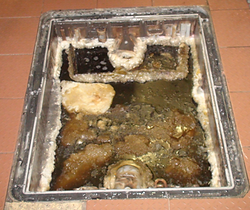
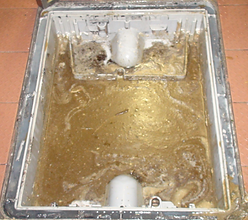
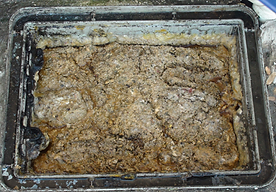


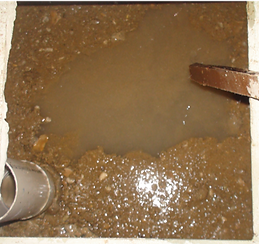

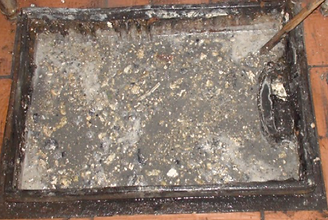
Las fotos muestran la aplicación manual del producto, como demostración, en trampas de grasa de varios Hoteles y Restaurantes. Para la limpieza sólo se utilizó un atomizador manual y no se extrajo ningún material de la trampa, simplemente se eliminó la grasa existente en la trampa. En algunos casos, el material flotante visible en la superficies son sólidos húmedos (restos de comida)
Estas demostraciones nunca llevan más de 10 minutos.

